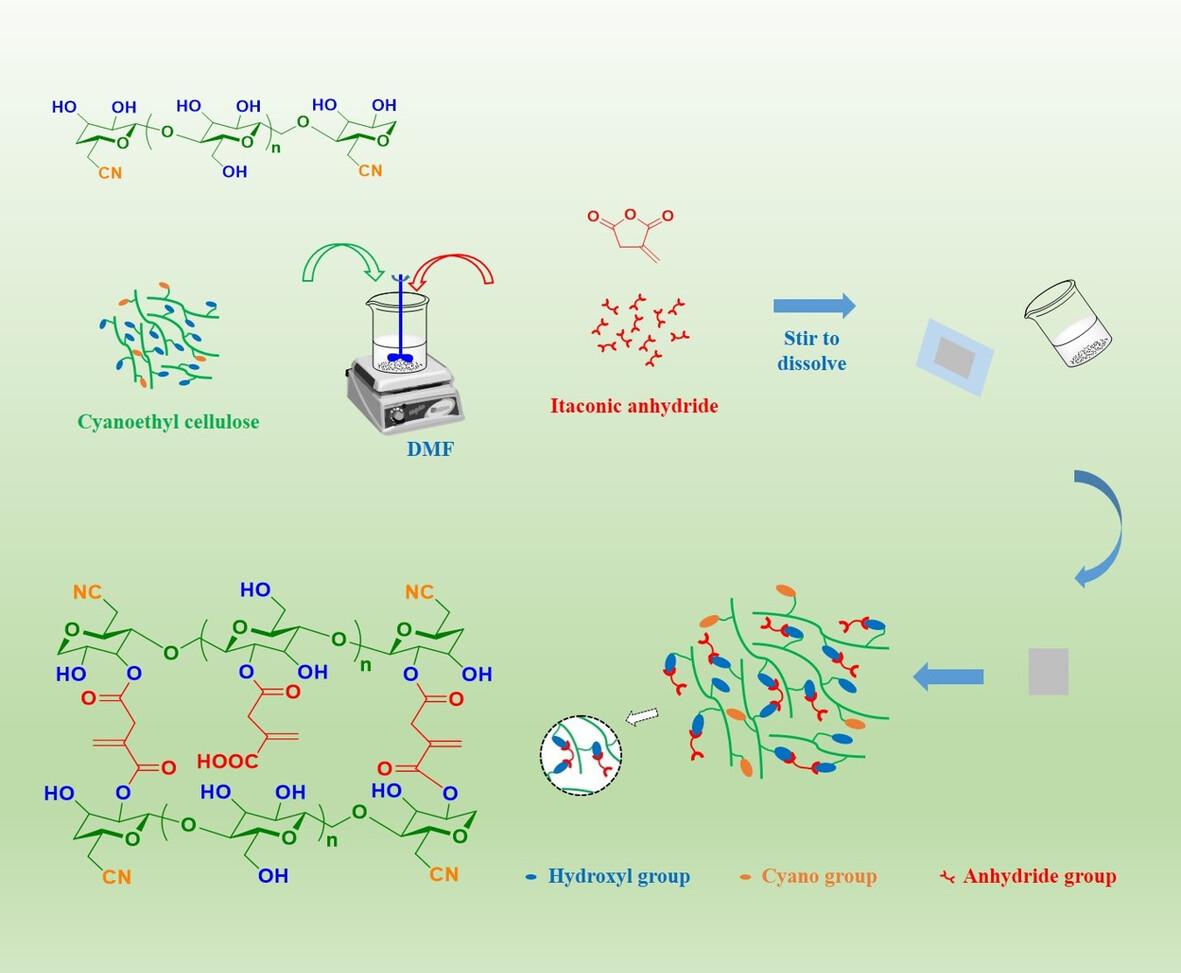Itaconic anhydride functionalized cyanoethyl cellulose with crosslinked structure enabled improved dielectric properties
Sen Cheng, Xinyu Wang, Rui Yang, Jiabao Wang, Chunhua Lu, Kai Guo, Ning Zhu, Xin Hu
求助PDF
{"title":"Itaconic anhydride functionalized cyanoethyl cellulose with crosslinked structure enabled improved dielectric properties","authors":"Sen Cheng, Xinyu Wang, Rui Yang, Jiabao Wang, Chunhua Lu, Kai Guo, Ning Zhu, Xin Hu","doi":"10.1002/pi.6680","DOIUrl":null,"url":null,"abstract":"<p>As a type of cellulose ether, cyanoethyl cellulose (CEC) is considered to be a promising candidate for polymer dielectrics due to its sustainable nature and high dielectric constant induced by the cyano groups. However, the relatively high conduction loss of CEC arising from the charge motion across the polymer degrades its dielectric properties. In this work, we designed and synthesized an all-organic polymer composite of CEC/itaconic anhydride (ITA) to improve dielectric properties. The CEC matrix was graft functionalized by ITA via an esterification reaction between the anhydride groups of ITA and hydroxyl groups of CEC. Meanwhile, crosslinking structure was also established in the composite by the generation of diester. Significantly improved dielectric constant (<i>ε</i><sub>r</sub>), elevated breakdown strength (<i>E</i><sub>b</sub>), restrained dielectric loss (tan <i>δ</i>) and decreased conductivity (<i>σ</i>) were observed in the composites compared with unmodified CEC. The <i>ε</i><sub>r</sub> increased from 17 for pure CEC to 32 for CEC/ITA at 1 kHz, and <i>E</i><sub>b</sub> also soared from 145 MV m<sup>−1</sup> for CEC to 226 MV m<sup>−1</sup> for the composite. The tan <i>δ</i> reduced from 0.24 for pure CEC to about 0.05 for the composite at 100 Hz. This should be attributed to the molecule trapping centers arising from the high electron affinity ITA and the formation of crosslinked networks as well as hydrogen bonding, which impeded the electric conduction. It also provided additional advantages of better dielectric properties for the CEC/ITA composites than pure CEC at high temperatures, which may offer inspiration for the design and preparation of bio-based dielectrics for high temperatures. © 2024 Society of Chemical Industry.</p>","PeriodicalId":20404,"journal":{"name":"Polymer International","volume":"73 12","pages":"1022-1029"},"PeriodicalIF":2.9000,"publicationDate":"2024-07-15","publicationTypes":"Journal Article","fieldsOfStudy":null,"isOpenAccess":false,"openAccessPdf":"","citationCount":"0","resultStr":null,"platform":"Semanticscholar","paperid":null,"PeriodicalName":"Polymer International","FirstCategoryId":"92","ListUrlMain":"https://onlinelibrary.wiley.com/doi/10.1002/pi.6680","RegionNum":4,"RegionCategory":"化学","ArticlePicture":[],"TitleCN":null,"AbstractTextCN":null,"PMCID":null,"EPubDate":"","PubModel":"","JCR":"Q2","JCRName":"POLYMER SCIENCE","Score":null,"Total":0}
引用次数: 0
引用
批量引用
Abstract
As a type of cellulose ether, cyanoethyl cellulose (CEC) is considered to be a promising candidate for polymer dielectrics due to its sustainable nature and high dielectric constant induced by the cyano groups. However, the relatively high conduction loss of CEC arising from the charge motion across the polymer degrades its dielectric properties. In this work, we designed and synthesized an all-organic polymer composite of CEC/itaconic anhydride (ITA) to improve dielectric properties. The CEC matrix was graft functionalized by ITA via an esterification reaction between the anhydride groups of ITA and hydroxyl groups of CEC. Meanwhile, crosslinking structure was also established in the composite by the generation of diester. Significantly improved dielectric constant (ε r ), elevated breakdown strength (E b ), restrained dielectric loss (tan δ ) and decreased conductivity (σ ) were observed in the composites compared with unmodified CEC. The ε r increased from 17 for pure CEC to 32 for CEC/ITA at 1 kHz, and E b also soared from 145 MV m−1 for CEC to 226 MV m−1 for the composite. The tan δ reduced from 0.24 for pure CEC to about 0.05 for the composite at 100 Hz. This should be attributed to the molecule trapping centers arising from the high electron affinity ITA and the formation of crosslinked networks as well as hydrogen bonding, which impeded the electric conduction. It also provided additional advantages of better dielectric properties for the CEC/ITA composites than pure CEC at high temperatures, which may offer inspiration for the design and preparation of bio-based dielectrics for high temperatures. © 2024 Society of Chemical Industry.
具有交联结构的衣康酸酐功能化氰乙基纤维素可改善介电性能
作为纤维素醚的一种,氰乙基纤维素(CEC)因其可持续的性质和氰基引起的高介电常数而被认为是聚合物电介质的理想候选材料。然而,由于电荷在聚合物上的运动,CEC 的传导损耗相对较高,从而降低了其介电性能。在这项工作中,我们设计并合成了一种 CEC/itaconic anhydride (ITA) 全有机聚合物复合材料,以改善介电性能。通过 ITA 的酸酐基团与 CEC 的羟基之间的酯化反应,ITA 对 CEC 基体进行了接枝功能化。同时,通过生成二酯,还在复合材料中建立了交联结构。与未改性的 CEC 相比,复合材料的介电常数 (εr)、击穿强度 (Eb)、介质损耗 (tan δ) 和电导率 (σ)均有明显改善。在 1 kHz 频率下,εr 从纯 CEC 的 17 增加到 CEC/ITA 的 32,Eb 也从 CEC 的 145 MV m-1 激增到复合材料的 226 MV m-1。在 100 Hz 时,tan δ 从纯 CEC 的 0.24 降至复合材料的约 0.05。这应归因于高电子亲和力的 ITA 所产生的分子捕获中心、交联网络的形成以及氢键作用阻碍了电传导。此外,与纯 CEC 相比,CEC/ITA 复合材料在高温下具有更好的介电性能,这为设计和制备高温生物基介电材料提供了灵感。© 2024 化学工业协会。
本文章由计算机程序翻译,如有差异,请以英文原文为准。



